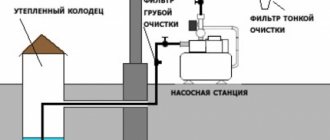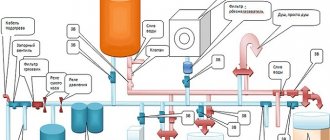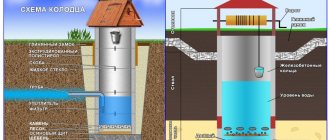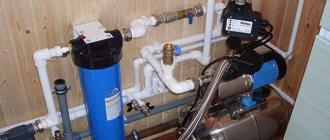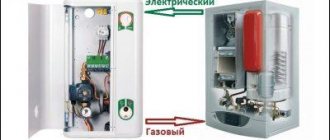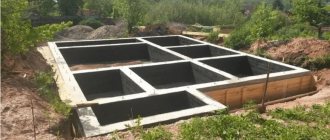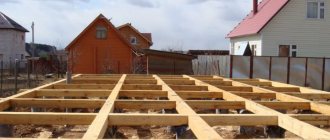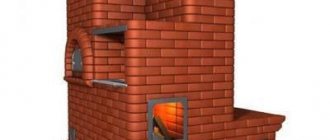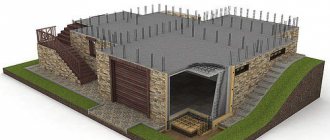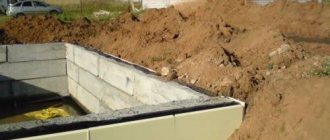Types of wells for water supply to a private house
Well on sand
Water is pumped from the surface sand layer. The depth of such a well is 20-40 m. A sand well has low productivity (up to 1.5 m3/hour) and is suitable for a small private house. During installation, the water supply system must be equipped with an additional filter to remove sand from the water.
Well for limestone (artesian well)
Water is taken from a deep limestone layer. The well depth reaches 200 m. Thanks to this, it has high productivity (up to 10 m3/hour) and is suitable for water supply to several areas or even a small village. In this case, the water from the limestone soil comes out clean and does not require additional treatment.
Drilling a limestone well is expensive. And you also need to obtain a license to use artesian waters, since they are the property of the state.
The choice of well type depends on the depth of the aquifer. Before constructing a well, test drilling is done to calculate the depth.
Abyssinian well
It is a stainless steel pipe with a tip and a mesh filter. The pipe is driven into the ground to the aquifer, 10-15 meters. A hand pump is connected to the outer end of the pipe. The Abyssinian well is rare, so we will not dwell on it in detail; we are more interested in water supply with a submersible pump.
Main characteristics of the well:
- Well depth.
Equal to the depth at which the aquifer lies. - Static level.
The highest level to which the well is filled. - Dynamic level.
The lowest level to which the pump can pump water. The water does not fall below it. - Well flow rate.
Well productivity, that is, its filling in 1 hour (m3/hour).
The characteristics of the well are indicated in the data sheet; they are necessary for selecting water supply equipment.
Advantages and disadvantages of sand and artesian wells
In order to set up a water supply system from a well with your own hands, both sandy and artesian sources are suitable.
If the water consumption in the house is no more than 1.5 m3/h, then the issue of introducing water supply is easily solved using a sand well. This volume is optimal enough to provide water to a small house.
The main advantages of a sand well are the low cost of construction, there is no need to resort to the help of large equipment and the speed of construction. But for a cottage where people live all year round, a sand well is not the best choice.
During the construction of such wells, aquifers, as a rule, lie no deeper than 50 meters, which does not guarantee crystal clear water. Although the water in a sand well is much cleaner than in a well, it may nevertheless contain various impurities and aggressive compounds. All this is due to the close location of the sandy aquifer to the surface water level.
The well's productivity is approximately 500 liters, and its service life is only about 10 years. Therefore, a water supply device of this type is not suitable for large cottages.
The best option is an artesian well, which is installed at a depth of 100 meters. The main advantage of this type of well is an unlimited supply of high quality water. Such a well can produce up to 10 m3/h. This is enough to provide water to a house and a decent area next to it. The service life of such a well, even with active use, can reach more than 50 years.
Water located at great depths is purified and filtered naturally. Due to this, it does not contain various impurities and bacteria that can harm human health. If you can equip a sand well yourself, then for an artesian well you need to resort to the help of specialists.
Although drilling an artesian well requires serious investments, there is no need to save money. This stage is best left to professional drillers who, based on the composition of the rocks that lie beneath the site, will be able to determine the aquifer and equip the well in accordance with all the rules of drilling technology.
By professionally constructing a well, rather than doing it yourself, you can get rid of a whole mountain of problems in the subsequent operation process.
Casing pipes for water supply wells
For wells, pipes made of plastic (HDPE, PVC) or metal are used. Plastic pipes are used more often because they are more cost-effective, do not corrode and are easier to install. However, plastic is subject to deformation and the pipe can be compressed by soil, so for wells longer than 60 meters metal pipes are used.
The most common sizes of plastic pipes:
- 113 mm (5 mm wall) is suitable for installing a 3-inch pump together with an adapter.
- 125 mm (7.2 mm wall HDPE and 5 mm PVC) with 3" pump and well adapter or 4" pump with head
Metal pipes for water supply can be welded or threaded. It is better to choose pipes with a welded connection, since the threads become loose over time under soil pressure. Metal pipes are durable, but they are more expensive than plastic ones, are susceptible to corrosion and are more difficult to cut out the inlet hole for the pipe - the bimetallic crown must be cooled with water all the time.
Metal pipe sizes:
- 89mm with 2" pump.
- 114mm with 3" pump.
- 127mm with 3" pump and adapter.
- 133 mm (once such pipes were used everywhere, today they are rare). Suitable for installation is a 4-inch pump, both with a head and in the version with an adapter.
Methods for organizing water supply from a well
There are two arrangement schemes: with an adapter and a caisson. The most profitable option is to use an adapter with a 3-inch pump. It is installed quickly and simply: below the freezing depth, a special device (adapter) is cut into the casing, through which water enters the supply pipe 32, and then into the house. To arrange this, pipes with a diameter of 113 mm or more are selected for the well.
Fig.3. Installation diagram of water supply from a well using an adapter
Construction of a well with a caisson will cost much more. On our website, the price of a plastic caisson starts from 39,000 rubles. However, in some cases, a well adapter cannot be used on a site, only a caisson. For example, when the water supply needs to be connected not to one building, but to several objects - to a bathhouse, a guest house or a neighboring dacha.
Fig.4. Scheme of well arrangement with caisson
Borehole adapter, installation of water supply from a well without a caisson
The adapter is a small connecting device. It allows you to insert the water supply pipe directly into the casing, without a caisson. Roughly speaking, this is an insertion into the casing below the freezing depth.
Downhole adapter device
Fig.8. Water supply diagram from a well to a house with a well adapter
Advantages of a water supply system with a well adapter:
- Low price. The cost of installing the adapter is 4,500 rubles. For comparison, installation of a caisson with a slab and anchoring costs from 25,000 rubles.
- Installation is less labor-intensive than in the case of a caisson. When installing a caisson, it is necessary to pour a concrete slab, anchor the container, sprinkle the central heating system, install the coupling hermetically and remove the pipe.
- Does not take up space on the site, unlike a caisson.
The adapter is not suitable if you need to supply water to several objects at once (sites or buildings on the same site). In such a situation - only a caisson. Besides:
- The adapter occupies approximately 2.5 cm in the pipe. This must be taken into account when selecting a pump by diameter.
- It is difficult to install. Both parts of the adapter need to be connected correctly on both sides of the casing, this requires skill.
More details in our article: caisson or well adapter.
How to install a borehole adapter:
— A hole is made in the casing pipe with a 40-44 mm bimetallic crown;
— One part of the adapter is screwed onto a metal rod, lowered into the pipe and inserted into the hole.
— The second part of the adapter is inserted into the pipe from the outside and screwed to the first through a sealed rubber ring.
— The third part with the pump connected to it is lowered into the well and inserted into the already secured threaded part of the adapter.
Video: Installing a Downhole Adapter
If you are interested in how to conduct water from a well using an adapter, use our guide to installing a well adapter yourself. Also, if you don’t want to do it yourself, we can install the well using a turnkey adapter.
Caisson
To protect the well head and the surface pump nearby from freezing and precipitation, it is recommended to install a caisson on top of it. This is a sealed structure made of plastic, concrete or brick. In shape it resembles a small well up to two meters deep with a tightly closing lid. In this case, the bottom should be in the soil below its freezing level.
The plastic version is purchased ready-made in the store. And you can make a concrete or brick structure with your own hands. The size of this structure in the autonomous water supply system of a private house is made such that a person can go down inside it to service the equipment installed there. For its exterior decoration, you can use inexpensive facade panels, porcelain stoneware and even roofing corrugated sheets.
Scheme of arrangement of a plastic caisson
If the cottage is built in a warm region, and the pump is selected to be submersible, then the caisson can be abandoned. In this case, the water pipe is unlikely to freeze. In all other situations, additional protection for the well and pumping equipment will not hurt. When choosing the type of foundation for a building, it is necessary to weigh the multiple pros and cons of a pile-grillage foundation and its other analogues. With a caisson everything is much simpler. It is almost always needed.
Selection of a pump for organizing water supply from a well
For water supply from a well, submersible pumps of small diameter are used - 2-4″ (50.8-101.6 mm). The Zagorod company most often installs Belamos TF centrifugal pumps with a diameter of 3″ (76.2 mm) in water supply systems.
Advantages of Belamos TF-3 well pumps:
- The body is made of high quality stainless steel and brass.
- There is a thermal protection system that turns off the engine if it overheats.
- Special seals allow the pump to be lowered 80 m below the water level.
- The pump operates with solids content up to 180 g/m³.
The water supply pump is selected taking into account the diameter of the casing pipe and the installation method. If a PVC pipe with an internal diameter of 107 mm (OD 125 mm, wall 9 mm) is used, then a 4 inch (101.6 mm) pump can be lowered into it. This option is suitable when installed through a caisson. When installed through a well adapter, it takes up approximately 1 inch (25 mm) inside the pipe and a 4-inch pump cannot be lowered into it, so a pump with a 3-inch diameter is installed.
Other popular pumps for water supply to a summer house or country cottage
Grundfos SQ-3.
Pump housing made of stainless steel. Diameter 3". Can pump water containing sand up to 50 g/cu.m. m. Built-in check valve and dry-running protection relay.
Fig. 10. Well pump Grundfos SQ 3-55
Belamos TF.
The body is made of stainless steel. Diameter 4″ (97 mm). Can pump water from a depth of up to 150 m, depending on the model. There is a built-in check valve. A pump with an optimal price-quality ratio.
Fig. 11. Well pump Belamos TF-25
Pumping stations for wells
In addition to submersible pumps, we install surface pumps (pumping stations) for wells. But there are nuances:
- The pumping station lifts water from a depth of no more than 8 meters.
- The pumping station is not used with a drain valve. When installing a caisson, this is not a problem; it can have a separate tap for draining water.
- To start the pumping station, there must be water in the system. It is filled through the station.
- The station creates noise during operation. It is better to install it in a dry, warm basement or in a separate technical room or in a caisson.
Important! Do not use the pumping station if the dynamic water level drops below 8 m. The station will not lift water from such a depth.
The Zagorod company provides water supply with Belamos and Grundfos MQ pumping stations.
Belamos Stations
already come assembled with a hydraulic tank and pressure switch. If the station overheats, it automatically turns off.
Grundfos MQ pumping stations
are equipped with a check valve, a pressure switch and a dry-running protection relay. They also have a built-in hydraulic tank, but it is small, so a hydraulic tank of the required volume is usually installed with the station.
Connection methods
Installation of an individual water supply in a house in any case requires the installation of a certain set of equipment. Based on what type of equipment this will be and where it will be located, one or another connection method is chosen.
Well
When installing water supply for a private house (cottage, dacha) from a well, you can use either a submersible pump or a pumping station. The second method will be cheaper, but it should be chosen when it is possible to locate the station as close to the well as possible. Otherwise, a loss of pump performance and a decrease in pressure are inevitable.
In addition, the station itself must be installed in a room protected from cold, taking into account that the operating unit produces a certain noise. A properly selected submersible pump will provide a stable supply even over long distances.
Detailed diagrams and estimates for installation
— [Section] Water supply from a well
Well
Non-centralized water supply to a private house from a well is organized using an adapter, or from a caisson.
Caisson
— is a container dug into the ground that contains all the equipment (pump and automation, fittings, filters). In this case, you will not need to look for a place to install all this. In addition, you will be able to bring out the required number of water supply branches (to a residential building, to a bathhouse, for irrigation, etc.). This is a fairly convenient and practical way of organizing water supply in a private home, the only “disadvantage” of which can only be called a relatively high price.
Adapter
- a more economical option. Both the fitting itself and the work to install it will be cheaper, but during operation, access to the adapter and pump will be difficult. In the future, repairs or replacement will require excavation and removal of part of the casing. This connection method is well suited for water supply to a summer house, which is used only in the summer.
Detailed diagrams and estimates for installation
— [Section] Water supply from a well
Automation for water supply wells
Downhole automation is conventionally divided into three generations:
First generation.
The simplest automation. Consists of a hydraulic accumulator, pressure switch and dry running relay (optional).
Second generation.
Control unit and electronic sensors. A hydraulic accumulator is not required.
Third generation.
Programmable systems allow you to control the pump up to adjusting the voltage supply to the motor.
Read more about automation systems for borehole pumps in our article automation for pumping equipment.
The Zagorod company installs first generation automation. It is simple, but inexpensive and reliable. The devices are mounted through a five-pin fitting (five-pin). The following is connected to the connector terminals:
- Pump.
- Internal water supply pipe.
- Pressure gauge.
- Hydraulic accumulator.
- Pressure switch.
Fig. 13. Scheme of water supply from a well with a hydraulic accumulator
Question! Is it possible to do without a hydraulic accumulator in a water supply system?
Yes, you can. To do this, it is necessary to install the appropriate automation (unlike well pumps, well pumps do not have built-in automation). However, comfortable conditions - with a standard of 20-30 starts - can only be achieved by using a hydraulic accumulator. Without a hydraulic tank, the pump will turn on every time the tap is opened, and the automation will not protect against water hammer.
The pressure switch turns the pump on or off when the pressure changes. At the bottom of the relay there is a metal membrane. When the taps are closed, the pressure increases, the membrane bends upward and moves the spring to a given range. When displaced, the circuit opens and the pump turns off. When the tap is opened and the pressure drops, the membrane returns to its original position. The spring opens and closes the circuit. The pump turns on. If there is water in the hydraulic tank, it enters the pipes and compensates for the pressure drop. The pump does not turn on, its working life is saved.
Do-it-yourself connection of a pressure switch in a water supply system from a well
Fig. 16. Electrical diagram for connecting the pump automation
Draining water from a well for the winter
To drain water for the winter, a drain valve is installed in a caisson. If an adapter is installed, an automatic drain valve is installed on the pipe in the well. Important: when using a surface pump (pumping station), the drain valve is not used.
Fig. 17. Operating principle of the drain valve
Watering tap
You can also remove the watering tap. When piping through an adapter, the tap is removed from the house. If a caisson is installed, then the output is made from the caisson. In summer, the tap is used for watering, in winter - for setting up a skating rink or slide on the playground.
Fig. 18. Removing the watering tap from the caisson
Fig. 19. Removing the watering tap from the house
House water supply unit
Entry is made in a technical room or bathroom through a 1” tee and a “1” ½ fitting. Then screw in the gland and clamp the cable. The seal is necessary to ensure tightness.
The input kit is usually three meters (the distance from the tee to the freezing point). In most cases, this is enough even if the house is on stilts.
Water treatment for a private home
Groundwater may contain excess chlorine, iron, manganese, calcium and magnesium. Special filters have been developed to purify water.
A water treatment system is a set of filters with different functions:
- Aeration filters remove iron. It oxidizes and precipitates;
- In filters for mechanical cleaning, large suspensions, sand, and rust particles are deposited;
- Activated carbon filters retain chlorine;
- In ion exchange filters, water is softened;
- pH filters even out the acid-base balance.
Before selecting equipment, you need to determine the chemical composition of the water, that is, find out what it needs to be purified from. It is recommended to immediately do a water analysis after pumping the well. If you buy a water treatment system from our company, we can take the water for analysis. It takes several days. After this, we will select equipment for water treatment. You can do the wiring of the filters according to the diagram yourself; it’s not difficult. We recommend ordering commissioning of the system from us.
Laying water pipes around the house
Collector wiring
They install common collectors (combs) for cold and hot water, from which pipes are drawn to each plumbing fixture. Thanks to this, you can use the bathtub, sink and kitchen sink at the same time, without any pressure surges.
Important! There are often errors in diagrams from the Internet. For example, in this diagram, the oblique filter is installed with the mesh facing up. This cannot be done: dirt will not get into the filter, and the pipe will become clogged over time. This must be taken into account when installing yourself.
When to use:
- If there are many water points in the house, you can shut off the water for each point separately.
- If pipes need to be hidden.
This wiring is most popular in cottages from 100 sq.m. made of aerated concrete or wooden frame. In large cottages it is easier to allocate space for collectors, and in the walls and floors of frame and aerated concrete houses it is easy to hide large quantities of pipes.
For collector wiring, pipes made of cross-linked polyethylene or metal-plastic 16 mm are used. Our standard option is a hidden collector distribution with metal-plastic pipes.
Tee wiring
Tee bends are installed on the pipes to the water collection points.
Applies when:
- There is little plumbing in the house.
- If the pipes cannot be laid hidden.
This wiring is cheaper and the system takes up little space. Ideal for houses and cottages with a small number of residents. The peculiarity of this wiring is that if you turn on the water at one water intake point, the pressure at subsequent ones drops.
For tee distribution of water supply, 20 mm polypropylene pipes are used. If there are more than 3 water supply points on one branch, then it is preferable to take a 25 mm PP pipe.
We draw up project documentation
Drawing up a project may be necessary if a residential building is undergoing a major overhaul with redevelopment or if it is recently built. To develop it based on the received technical conditions, you can contact private architectural firms or designers of the organization that owns the water source.
When compiling it, the number of residents in the house, the volume of water consumed, the location of bathrooms and household appliances, and the presence of other sources of water are taken into account. When developing a project, the design organization will need a site and house plan (drawings of a residential building and a topographic survey of the site), the type of plumbing used in the housing, and a list of operational requirements.
The finished project should answer questions about:
- choosing a wiring diagram for cold and hot water when using a water intake source for a heating system;
- selection of pipe materials and sizes;
- the thickness of the screed if the water main is located in the floor;
- the amount of materials and plumbing fittings required for installation work;
- pressure - are booster pumps required for wells?
The customer must receive from the organization that has the right to draw up project documentation a document with the following content:
- title page with general data and explanatory note;
- master plan with the layout of the main water main;
- diagram of the water supply line in the house, indicating the main components and placement points of shut-off valves;
- axonometric diagram of the water supply and boiler room;
- specification of the materials used and plumbing fittings.
Fig. 4 Water supply connection project - example
Hot water supply from a well to the house
To heat water for autonomous water supply, an electric heating boiler (water heater) is used. Such heaters have a storage tank of 50-200 liters. When selecting a water heater, pay attention to the volume of the tank and the power of the unit. The higher the power, the faster the water heats up. Standard power is 1.5-2 kW. With it, 100 liters will heat up in 3 hours.
When installing a boiler, it is imperative to provide for water drainage; for this, a drain valve is installed at the cold water inlet.
If a gas main is laid to the cottage or dacha, then it is beneficial to purchase a gas water heater for hot water supply.
You can also make a water supply from a heating boiler. For example, from a double-circuit gas boiler. But in this option there is a limitation of up to 12 l/s, which is enough if there are up to 3 points in the house where it is supplied. If you need more, you need to use an indirect heating boiler; in this method, you can circulate hot water
Features of various water supply systems
Water without impurities (iron oxide, copper and molybdenum) enters the house from a well. Filtration is ensured by the passage of groundwater through a layer of loam and pebbles. This water supply scheme for a cottage involves laying a well at a depth of up to 50 m. This creates a water supply of up to 500 liters. The service life of the system is up to 7 years.
An alternative option is drilling to depth. The machine method is used. Cleaning is done using replaceable filters. This is enough for domestic purposes, but seasonality is taken into account when insulating the structure.
Summer water supply:
- Laying the pipeline on the surface. It is permissible to organize a shallow trench. Connection according to a series circuit (preservation without forced drainage).
- There is no need to install pumping equipment or arrange a caisson.
- Storage tanks are not additionally insulated.
- Pipes are placed in the walls (during the construction of a bathhouse). No drilling work is being carried out in the basement.
The owner of a country house organizes the water supply at minimal cost. However, there are nuances. With such cost optimization, the possibility of mechanized fluid supply is eliminated. At the end of the summer season, the structure is dismantled (temporary installation) or the water is drained.
Winter water supply:
- Installation of internal wiring with a slope of up to 1 m. Parallel connection with collector combs.
- Installation of a cascade of pumping units. Provides maximum fluid pressure.
- The outer part of the pipeline is laid below the freezing level of the soil. Geological work is carried out in advance.
- Storage tanks are installed in a room where the temperature is always above zero (attic, dressing room).
- The section of the pipeline at the entrance to the room is additionally equipped with a heating cable. Installation of an insulating box is allowed.
A prerequisite for a stable water supply in winter is the installation of conservation elements. This is the removal of liquid from a pipeline. The procedure is carried out by opening pre-installed drain valves (electromagnetic devices).
Do-it-yourself water supply at home from a well
What will you need for self-installation?
Hot air gun.
If water supply is installed from a well or from a well with a caisson, then the pump is connected through a heat-shrinkable sleeve. To make the clutch seat, it is heated with a hairdryer.
T-shaped installation key.
It is screwed into the adapter with the pump connected. You can buy it at a hardware store for 1000 rubles. or make it yourself from metal or polypropylene pipes.
Mounting key for lowering the adapter with the pump into the well.
You can make it yourself from metal pipes.
L-shaped mounting wrench.
You can also make it yourself from metal pipes. The end must have an external thread.
Bimetallic crown with a diameter of 44 mm.
For drilling a hole when installing a downhole adapter.
Soldering iron (“iron”).
Needed for soldering polypropylene pipes. Average price – 3000 rub.
Apparatus for welding polypropylene pipes.
Press jaws
. Connections through press fittings are one-time, permanent, so they can be hidden under the screed. For installation, special presses are used, manual or electric. Manual press pliers cost about 6,000 rubles, electric ones cost about 50,000 thousand rubles. This must be kept in mind if you plan to install it yourself.
Fitting.
For installation of metal-plastic pipes, crimp or press fittings are used. Compression fittings are tightened with a compression nut. The nut must be tightened from time to time, so the pipeline with such fittings must be visible.
Adjustable wrench.
Required for installation of fittings.
"Swede".
With its help, pipes and other elements without edges are captured.
Sealant.
To seal threaded connections, it is recommended to use plumber's flax and paste (putty), for example, Unipak. Fum tape and other similar materials are highly discouraged.
